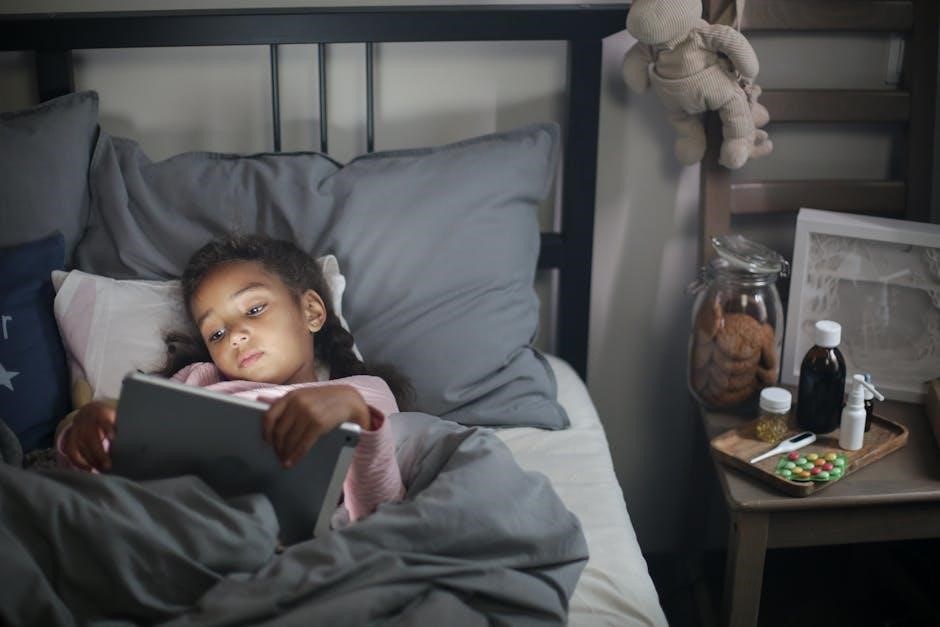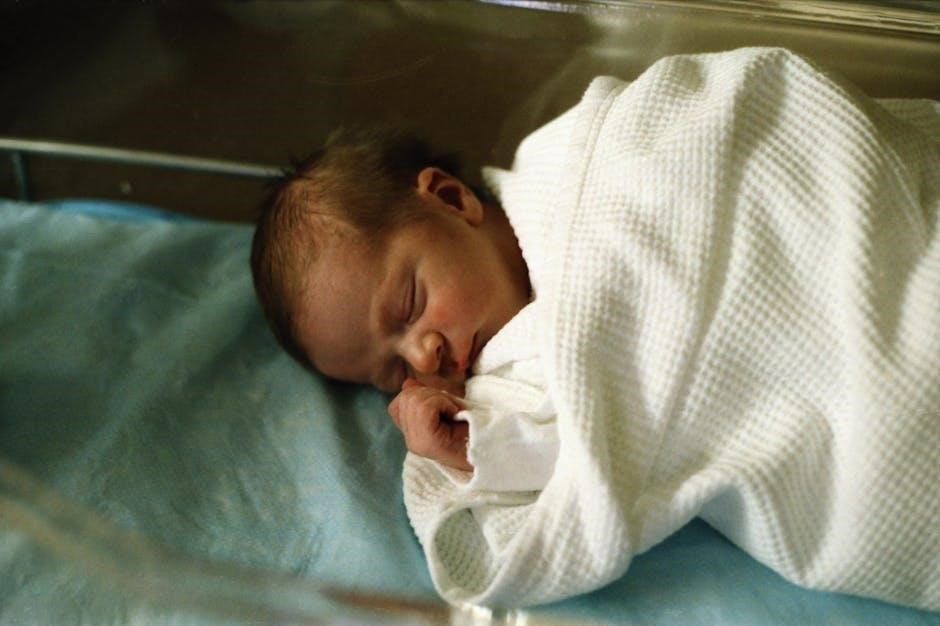Pediatric sleep disorders are common and can significantly impact a child’s physical‚ emotional‚ and cognitive development. Early identification is crucial to prevent long-term health consequences. Tools like the BEARS screening instrument help evaluate sleep issues in children aged 2-18 years.

What is the BEARS Sleep Screening Tool?
The BEARS Sleep Screening Tool is a user-friendly instrument designed to identify sleep problems in children aged 2-18 years. It evaluates five key domains: Bedtime Issues‚ Excessive Daytime Sleepiness‚ Night Awakenings‚ Regularity and Duration of Sleep‚ and Sleep-Disordered Breathing.
B ー Bedtime Issues
Bedtime issues are a common concern in pediatric sleep disorders‚ often manifesting as difficulty falling asleep or maintaining a consistent sleep schedule. The BEARS Sleep Screening Tool addresses this domain by asking age-appropriate questions to identify problems related to bedtime routines. For younger children (1-2 years)‚ questions focus on consistent bedtime times and the presence of calming pre-sleep activities‚ such as reading a book together. For preschoolers (3-5 years)‚ the tool assesses whether electronic devices are avoided before bed and if soothing strategies are used to help the child fall asleep. In grade school-age children (6-12 years)‚ the emphasis shifts to screen time avoidance and the use of TVs or tablets as sleep aids. Adolescents (13-18 years) are evaluated on their ability to avoid stimulating activities before bed and establish a relaxing bedtime routine. These questions help clinicians understand whether bedtime struggles are contributing to broader sleep problems‚ such as insufficient sleep duration or poor sleep quality‚ which can impact daytime functioning and overall health. Early identification of bedtime issues is critical for implementing effective interventions to improve sleep hygiene and long-term well-being.
E ー Excessive Daytime Sleepiness
Excessive daytime sleepiness (EDS) is a key domain assessed by the BEARS Sleep Screening Tool‚ as it often indicates underlying sleep problems in children. The tool includes questions to evaluate whether a child feels overly sleepy during the day‚ struggles to stay awake‚ or experiences unintended sleep episodes. For younger children‚ questions may focus on behaviors like difficulty staying awake during activities or excessive napping. In older children and adolescents‚ the emphasis shifts to issues like falling asleep in class or while doing homework‚ as well as daytime fatigue that interferes with daily routines. The BEARS tool also considers age-appropriate triggers‚ such as screen time before bed or irregular sleep schedules‚ which can contribute to EDS. Identifying excessive daytime sleepiness is crucial because it can signal conditions like sleep apnea‚ insomnia‚ or poor sleep hygiene. Addressing this issue early can improve cognitive function‚ mood‚ and overall quality of life for children. Clinicians use these insights to guide further evaluation and interventions tailored to the child’s needs.
A ー Night Awakenings
Night awakenings are a common issue in pediatric sleep disorders‚ often assessed through the BEARS Sleep Screening Tool. This domain focuses on identifying how frequently a child wakes up during the night and the underlying causes of these interruptions. Questions in this section aim to determine if awakenings are due to difficulties falling back asleep‚ nightmares‚ discomfort‚ or other factors. For younger children‚ the tool may inquire about nighttime fears or dependence on parents to fall asleep again. In older children and adolescents‚ questions might address restless sleep or repeated awakenings without clear triggers. The BEARS tool also considers the impact of these awakenings on the child’s sleep quality and daytime functioning. Frequent or persistent night awakenings can signal underlying sleep disorders such as sleep apnea‚ restless legs syndrome‚ or anxiety-related issues. Clinicians use this information to guide further evaluation and develop targeted interventions to improve sleep continuity and overall well-being for the child. Addressing night awakenings is essential to ensure adequate rest and healthy sleep patterns.
R ー Regularity and Duration of Sleep
The regularity and duration of sleep are critical components of the BEARS Sleep Screening Tool‚ focusing on whether a child maintains consistent sleep patterns and meets age-appropriate sleep duration guidelines. This domain evaluates the child’s ability to establish a regular sleep schedule and assesses the total time spent sleeping each night. Questions in this section inquire about bedtime routines‚ consistency of sleep and wake times‚ and the presence of irregular sleep-wake cycles. Additionally‚ the tool examines whether the child’s sleep duration aligns with recommendations for their age group‚ ensuring they are getting sufficient rest for healthy development. Irregular sleep patterns or inadequate sleep duration can lead to daytime sleepiness‚ behavioral issues‚ and other developmental challenges. The BEARS tool helps clinicians identify sleep irregularities so they can provide guidance on establishing a consistent sleep routine and improving sleep quality. Addressing these factors is vital for promoting optimal sleep health and overall well-being in children.

S ー Sleep-Disordered Breathing
Sleep-disordered breathing (SDB) is the final domain assessed by the BEARS Sleep Screening Tool‚ focusing on identifying breathing-related sleep issues in children. This component evaluates symptoms such as snoring‚ breathing difficulties‚ and pauses in breathing during sleep‚ which may indicate conditions like obstructive sleep apnea (OSA). The questions in this section are designed to detect abnormal breathing patterns that could disrupt sleep quality and overall health. For example‚ parents or caregivers are asked if the child snores loudly or consistently‚ or if they experience breathing pauses or labored breathing during sleep. These questions help clinicians identify potential sleep apnea or other respiratory-related sleep disturbances. Early detection of SDB is crucial‚ as untreated sleep-disordered breathing can lead to sleep fragmentation‚ daytime sleepiness‚ and behavioral or cognitive difficulties in children. The BEARS tool provides a straightforward way to assess these concerns and guide further evaluation or referral to a sleep specialist if needed. Addressing SDB is essential for ensuring healthy sleep and preventing long-term complications.

Importance of Sleep Screening in Pediatrics
Sleep screening is a critical component of pediatric care‚ as sleep plays a vital role in a child’s physical‚ emotional‚ and cognitive development. Sleep disorders‚ such as insomnia‚ sleep apnea‚ or excessive daytime sleepiness‚ can significantly impact a child’s health and daily functioning. Early identification of sleep issues is essential to prevent long-term consequences‚ such as behavioral problems‚ learning difficulties‚ and compromised growth. Tools like the BEARS Sleep Screening Tool and the Pediatric Sleep Questionnaire (PSQ) are designed to help clinicians detect sleep-related problems early‚ ensuring timely interventions. Sleep screening also promotes better overall health‚ as adequate sleep is linked to improved immune function‚ emotional regulation‚ and academic performance. By addressing sleep concerns‚ healthcare providers can enhance a child’s quality of life and support their developmental milestones. Regular sleep assessments are therefore a cornerstone of comprehensive pediatric care‚ fostering healthier outcomes for children.

Structure of the Pediatric Sleep Questionnaire
The Pediatric Sleep Questionnaire is divided into five key domains: Bedtime Issues‚ Excessive Daytime Sleepiness‚ Night Awakenings‚ Regularity and Duration of Sleep‚ and Sleep-Disordered Breathing. Each domain includes age-appropriate questions to assess sleep patterns and potential disorders.
Age-Appropriate Questions
The BEARS Sleep Screening Tool incorporates age-appropriate questions tailored to different developmental stages‚ ensuring relevance and accuracy in assessing sleep patterns. For younger children (1-2 years)‚ questions focus on consistent bedtime routines and difficulty falling asleep. Preschoolers (3-5 years) are assessed on habits like screen time before bed and nighttime awakenings. School-age children (6-12 years) are evaluated on sleep duration‚ daytime sleepiness‚ and sleep environment. Adolescents (13-18 years) face questions about sleep hygiene‚ electronic device use‚ and sleep disruptions due to stress or school demands. These tailored questions help clinicians identify sleep issues specific to each age group‚ ensuring comprehensive and effective screening.
Clinical Interview Guide
The Clinical Interview Guide within the Pediatric Sleep Questionnaire is a structured framework designed to help clinicians effectively assess sleep-related concerns in children. It provides a systematic approach to gathering information about a child’s sleep patterns‚ ensuring that all relevant aspects are addressed. The guide aligns with the BEARS Sleep Screening Tool‚ offering prompts for each of the five key sleep domains: Bedtime Issues‚ Excessive Daytime Sleepiness‚ Night Awakenings‚ Regularity and Duration of Sleep‚ and Sleep-Disordered Breathing. Clinicians are encouraged to tailor questions to the child’s age and developmental stage‚ ensuring clarity and relevance. For example‚ younger children may be asked about bedtime struggles‚ while adolescents might be queried about sleep hygiene practices or daytime sleepiness. The guide emphasizes open-ended questions to encourage detailed responses‚ helping to identify underlying issues. It also includes suggestions for observing nonverbal cues and engaging both the child and caregiver in the conversation. This approach ensures a comprehensive understanding of the child’s sleep habits and any potential disorders. The guide is simple‚ quick‚ and practical‚ making it an invaluable resource for primary care settings.

How to Use the BEARS Tool
The BEARS tool is a quick screening instrument for pediatric sleep issues. Administer the five domains (Bedtime‚ Excessive Daytime Sleepiness‚ Night Awakenings‚ Regularity‚ and Sleep-Disordered Breathing) using age-appropriate trigger questions. Ideal for primary care settings.

Administration Guidelines
The BEARS sleep screening tool is designed for efficient use in primary care settings. Clinicians should introduce the tool to parents or caregivers‚ ensuring understanding of its purpose. Each of the five domains (B‚ E‚ A‚ R‚ S) includes age-appropriate questions tailored to the child’s developmental stage. For younger children (ages 2-5)‚ questions focus on bedtime routines and parental observations. For older children (ages 6-12)‚ questions may include school performance and daytime behavior. Adolescents (ages 13-18) are encouraged to self-report symptoms like daytime sleepiness or difficulty sleeping. The tool is administered in a clinical interview format‚ with clinicians guiding the conversation to cover all domains. Questions should be clear and concise‚ allowing for open-ended responses to gather detailed information. The screening process typically takes 5-10 minutes‚ making it suitable for busy clinical environments. Clinicians should be attentive to red flags‚ such as persistent nighttime awakenings or excessive daytime sleepiness‚ which may indicate the need for further evaluation. The tool’s simplicity and user-friendly design make it an effective first step in identifying pediatric sleep disorders.
Interpretation of Results
The BEARS tool provides a structured approach to interpreting results‚ focusing on the five key sleep domains. Positive responses in any domain indicate potential sleep issues requiring further investigation. Bedtime difficulties may suggest behavioral or environmental challenges‚ while excessive daytime sleepiness could point to sleep apnea or insufficient sleep. Night awakenings might indicate anxiety or sleep disorders like insomnia. Irregular sleep patterns or short sleep duration could signal circadian rhythm issues or poor sleep hygiene. Snoring or breathing difficulties during sleep may warrant further evaluation for sleep-disordered breathing. Clinicians should consider the child’s age and developmental stage when interpreting responses. Positive findings in multiple domains increase the likelihood of a sleep disorder. The tool’s results guide clinicians in referring children for specialized sleep studies or interventions. Early identification of sleep problems is critical to improving long-term health outcomes. The BEARS tool serves as a valuable first step in addressing pediatric sleep concerns.

Clinical Applications of the BEARS Tool
The BEARS tool is widely used in primary care settings to quickly identify pediatric sleep issues. It is also applied in specialized sleep clinics for comprehensive assessments‚ aiding in early intervention and tailored treatment plans for children.
Primary Care Settings
The BEARS tool is particularly valuable in primary care settings‚ where it serves as a quick and effective method for identifying sleep issues in children. Primary care physicians often encounter children with sleep-related problems‚ and the BEARS tool provides a user-friendly approach to assess these concerns during routine visits. By focusing on the five key domains—Bedtime Issues‚ Excessive Daytime Sleepiness‚ Night Awakenings‚ Regularity and Duration of Sleep‚ and Sleep-Disordered Breathing—clinicians can efficiently screen for common pediatric sleep disorders. The tool’s simplicity and age-appropriate questions make it ideal for busy primary care environments‚ allowing for early detection and intervention. This early identification can lead to timely referrals or interventions‚ improving overall patient outcomes. The BEARS tool not only aids in diagnosing sleep problems but also empowers clinicians to address these issues comprehensively‚ ensuring better sleep health for children aged 2 to 18 years.
Specialized Sleep Clinics
Specialized sleep clinics play a critical role in the comprehensive evaluation and management of pediatric sleep disorders. These clinics utilize advanced diagnostic tools‚ such as polysomnography and actigraphy‚ to thoroughly assess sleep patterns and identify underlying conditions. The BEARS tool is often used as an initial screening instrument in these settings to guide further investigation. Clinicians in specialized sleep clinics can delve deeper into the five domains of sleep assessed by the BEARS tool‚ tailoring interventions to address specific issues like sleep-disordered breathing‚ nighttime awakenings‚ or excessive daytime sleepiness. These clinics also offer multidisciplinary care‚ involving pediatric sleep specialists‚ psychologists‚ and respiratory therapists‚ to provide holistic management plans. For children with complex sleep disorders‚ such as obstructive sleep apnea or narcolepsy‚ specialized sleep clinics are essential for accurate diagnosis and targeted therapies. The integration of the BEARS tool with other diagnostic methods ensures a thorough approach to improving sleep health in pediatric populations.

Limitations of the BEARS Tool
The BEARS tool is a screening instrument‚ not diagnostic‚ requiring follow-up testing for definitive diagnoses. It may miss complex sleep issues and relies on caregiver reports‚ which can introduce bias or inaccuracies in responses.
Potential Drawbacks
The BEARS tool‚ while effective for screening‚ has several limitations. It is not diagnostic‚ requiring additional testing for confirmation of sleep disorders. Reliance on caregiver reports may introduce subjectivity or inaccuracies. Younger children’s inability to self-report and limited coverage of less common sleep disorders are notable gaps. Cultural and socioeconomic differences in sleep practices may affect responses. The tool’s reliance on clinical interpretation can lead to variability in identifying risk levels. These factors highlight the need for complementary assessments in comprehensive sleep evaluations.

Need for Follow-Up Testing
While the BEARS tool is an effective screening instrument‚ it is not a diagnostic tool. Positive results from the BEARS questionnaire indicate the need for further evaluation to confirm the presence and severity of sleep disorders. Follow-up testing is essential to ensure accurate diagnoses and appropriate treatment plans. For example‚ children screening positive for sleep-disordered breathing may require polysomnography (a sleep study) to confirm sleep apnea. Similarly‚ excessive daytime sleepiness may necessitate additional assessments‚ such as the Epworth Sleepiness Scale or actigraphy‚ to measure sleep patterns. Clinical interviews and sleep diaries can also provide more detailed insights. The subjective nature of the BEARS tool‚ which relies on caregiver or patient reports‚ underscores the importance of objective follow-up testing. Without further evaluation‚ sleep disorders may remain undiagnosed or misdiagnosed‚ leading to inadequate treatment. Thus‚ the BEARS tool should always be used as a first step‚ with comprehensive follow-up testing to guide clinical decision-making and improve patient outcomes.
